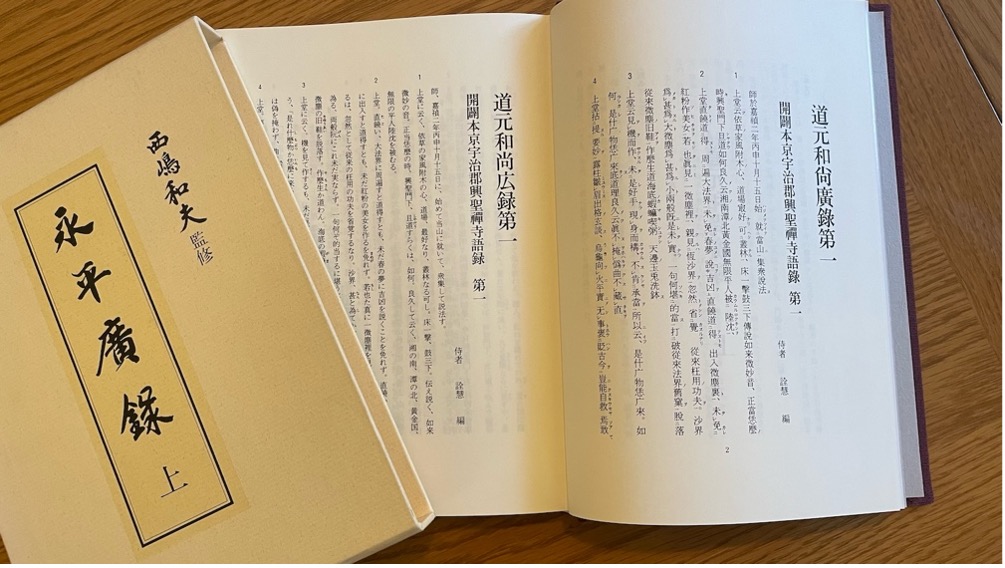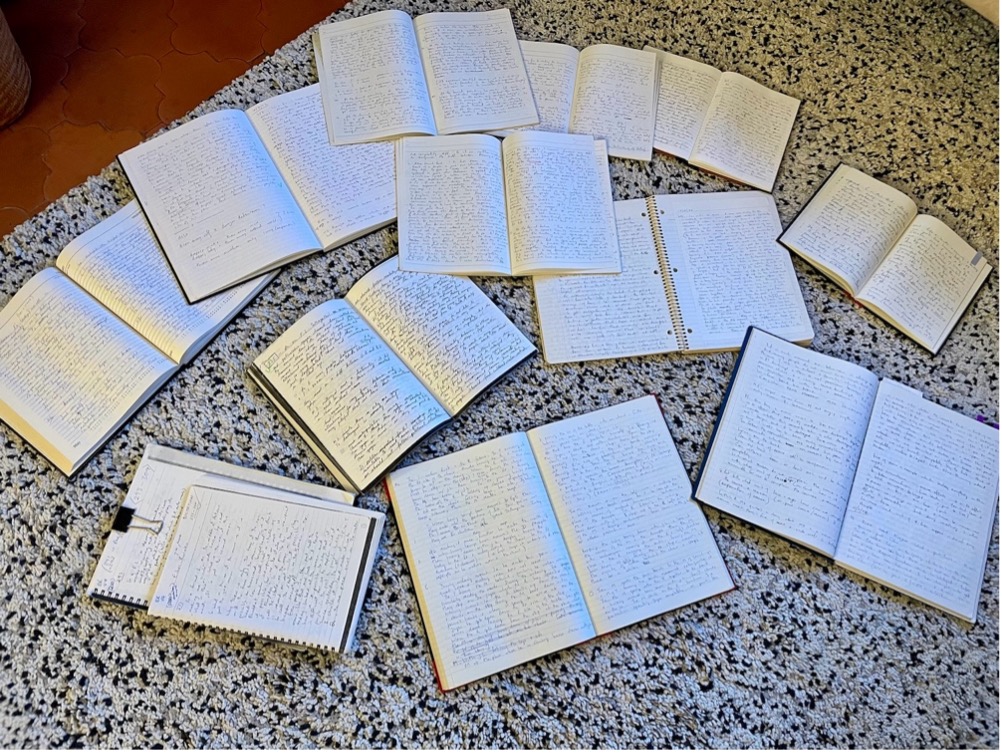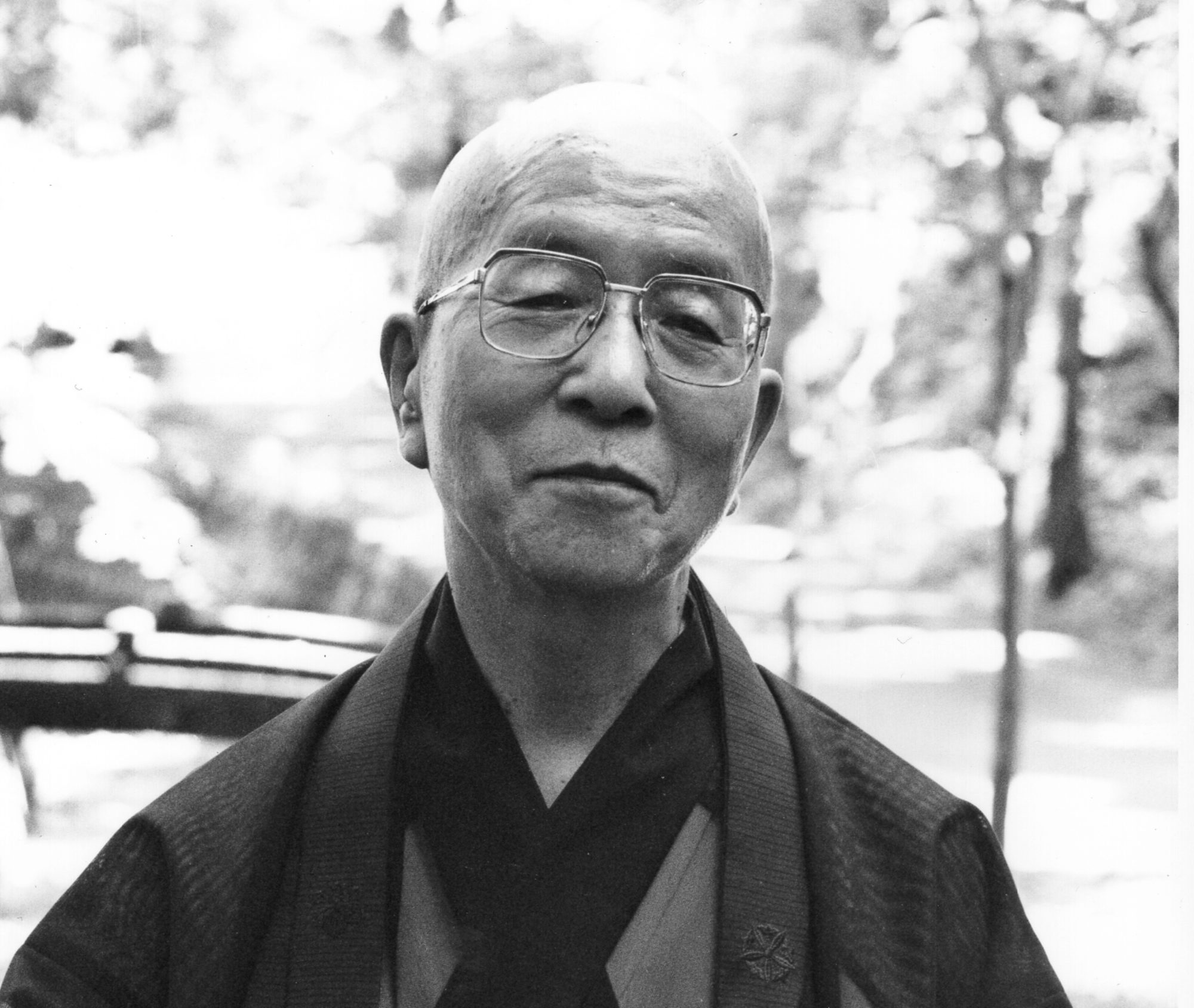The following is a translation of the Preface from Nishijima Rōshi’s 2-volume Eihei Kōroku, comprising the original Chinese text and his Japanese transliteration, privately published in an edition of 500 copies by Ida Ryōgokudō in 1991. This is the text Nishijima Rōshi used most often to dictate his English translations.
Preface
The Eihei Kōroku (永平広録) is a compilation of Master Dogen’s works that include: Jōdō (上堂); Shōsan (小参); Hōgo (法語); Juko (頌古); Shinsan (真賛); Jisan (自賛); and Geju (偈頌).
Jōdō means a formal Buddhist lecture given in a building called the Hattō (法堂), built as a hall where the Master delivers sermons or lectures to the assembled monks. Shōsan means an informal lecture that is delivered in a place other than in the Hattō, such as the Master’s private room. Hōgo means a lecture delivered at a Hosshiki (法式), that is, a Buddhist ceremony, held in the temple. Juko means praising poems concerning ancestral Masters. Shinsan are praising poems or verses for portraits of the ancient Masters, and Jisan are praising verses by Master Dogen for his own portrait. Finally, Geju refers to poems that Master Dogen wrote from time to time in his daily life.
The Eihei Kōroku consists of ten volumes in total. Volumes One to Seven comprise Jōdō, formal lectures; Volume Eight contains Shōsan, informal lectures, and Hōgo, lectures given in various ceremonies; Volume Nine comprises stories of ancient masters and accompanying Juko, praising poems; and Volume Ten contains Shinsan, verses praising portraits, Jisan, verses praising his own portrait, and Geju, miscellaneous poems.
The main impression I received when I first read the Eihei Kōroku was that the philosophy described in these volumes was equivalent to the ultimate conclusions of Master Dogen’s philosophy. In particular, the Jōdō represent a collection of lectures conducted in front of the assembled monks summoned to the formal setting of the Hattō. Therefore, the Buddhist philosophy that Master Dogen developed over the years was concentrated into such lectures and presented as the straightforward conclusion of his philosophy. Master Dogen’s Shōbōgenzō – The Right-Dharma-Eye Treasury – provides detailed explanations concerning Buddhist philosophy. Shōbōgenzō presents Buddhism as practice, and at the same time, it is an indispensable and valuable document with which to research Buddhism from the viewpoint of elucidating its philosophy. However, I am sure that there is nothing better than this Eihei Kōroku to quickly learn the conclusion of what Master Dogen believed Buddhism to truly be. And if I am questioned as to what then is the conclusion described in these volumes, I would simply say: “The Buddhist Way is the pursuit of existence – or Reality.” For a long time human beings have forgotten how to touch Reality itself, being clouded by intellectual thoughts and sensory stimuli.
In a corner of the Orient, Shakyamuni Buddha eventually experienced enlightenment under the Bodhi tree and affirmed that we are living in Reality. His philosophy was inherited over generations of Masters and the 28th Master, Bodhidharma, brought it to China. Further, this philosophy was later brought to Japan by Master Dogen. However, this stream of philosophy based on Reality could not become the main stream to dominate global philosophies.
The two main streams of global philosophies are that of idealism, which values the function of the intellect, as suggested by the Greek philosopher, Plato; and its opposing philosophy, materialism, which denies such idealism. Then for over a thousand years, human beings continued making superficial conceptual arguments between idealism and materialism, forgetting the simple fact that we are actually living in this real world.
However, from the middle of the 18th century, human beings started looking into such Reality, represented by the dialectics suggested by Hegel and Marx, and followed by existentialism, pragmatism, and phenomenology. I believe that human beings’ research into Reality has been deepening as the years go by. In this flow of human philosophy, the importance of Eihei Kōroku is great as one of the written works that explained Buddha’s teachings and which advises us to affirm that “we are living in this world of Reality” in the clearest words. As the editor-in-chief of this book, I hope that many people will enter into the philosophy of Realism as presented by Master Dogen through the work of Eihei Kōroku.

Nishijima Rōshi’s Eihei Kōroku
As the source for this book, I used a copy of Eihei Zenji Roku (Record of Master Eihei) owned by the Headquarters of Eiheiji Temple, which was given to me in the past by my own Master, Reverend Master Renpō Niwa. I would like to offer my deepest appreciation for his great kindness to me.
January, Third Year of Heisei (1991)
In my office in Ichigaya
Kazuo Nishijima
(Dōjō Master of Ida Ryōgokudō Zazen Dōjō)
Translation by Reiko Pearson, February 2024.
~~~~~~~~~~~~~~~~~~~~~~~~~~~~~~~~~~
Note on the Dictated Translations
These English translations of Dōgen Zenji’s Eihei Kōrorku dictated by Nishijima Rōshi were mainly recorded by his student, Jeremy Pearson, between 29 May 1990 and 15 July 1995 at the Ida Ryōgokudō Zazen Dōjō, in Ichikawa, Chiba, Nishijima Rōshi’s office at the Ida Ryōgokudō company in Ichigaya, Tokyo, and on occasion, during the 3-day summer retreats that Nishijima Rōshi held at Tōkei-in temple in the Shizuoka countryside.
Thanks are due to Dojo members, Fred Court and David Schilling, who both took a substantial number of dictations for Volumes 4 and 5 in 1993 and 1994.
Listening to Nishijima Sensei reading out Master Dōgen’s words was a privileged experience – like attending a lecture by Dōgen himself. Sensei would answer questions and explain meanings with his usual direct and realistic approach to everything. It was hard work for him to translate and read out each lecture one-by-one and for me to write quickly and keep up with his voice. Then, suddenly, it would be lunchtime and we would repair to Sensei’s favourite restaurant across the road from his office for tonkatsu, miso soup, and a bowl of rice. Happy days.
These dictations, transcribed in multiple notebooks, are now being transcribed again into digital format, with minimal editing, and hopefully will form another resource for those studying Dōgen Zenji’s philosophy and putting into practice Nishijima Rōshi’s teachings.

Dictation notebooks
Eihei Koroku Volume 1
Eihei Koroku Volume 2
Eihei Koroku Volume 5
Eihei Koroku Volume 6
Eihei Koroku Volume 7
Eihei Koroku Volume 8
For an excellent and complete English translation of the Eihei Kōroku with extensive introductory materials, notes, and references see:
Taigen Dan Leighton & Shohaku Okumura trans. Dōgen’s Extensive Record – a Translation of the Eihei Kōroku. Boston: Wisdom Publications, 2004.
